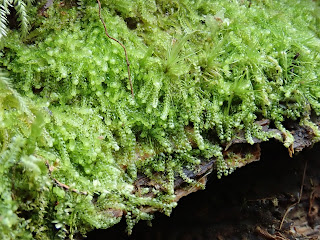The relatively care-free days of social distancing (but no lockdown) seem a long while ago already, but as I write it's only been 10 days. On Sunday 22nd March, sensing what might be coming, I took a trip to Cwm Cydfin near Leckwith - a tricky to access wooded stream valley that runs down into the River Ely. This short valley straddles three different tetrads so the GPS needed to be regularly checked to be sure which square I was in at any particular point.
After a bit of scrambling over fallen trees I came to a nice soft cliff section. The whole valley is calcareous so it was no surprise to find Fissidens incurvus, Eucladium verticillatum and Riccardia chamaedryfolia here, in fact the latter species was surprisingly frequent down the entire length of the stream. More of a surprise was Rhynchostegiella teneriffae, new for my home hectad ST17.
A little further downstream, a very rotten oak log that bridged the stream supported plenty of Tetraphis pellucica and a few patches of Nowellia curvifolia - also new for ST17.
The five south-easternmost records on the map above were all made by me in the last four years, suggesting this species is spreading into the less humid areas of the county.
To round off a fun couple of hours, a Scarce Fungus Weevil Platyrhinus resinosus was found on an ash log with numerous Daldinia fruit bodies on it.
This little valley proved a lot more productive than I expected, and added 38 new tetrad records for ST17L, S and R.








Great stuff George, R. teneriffae is a nice record. The map for Nowellia lalso ooks pretty good. It wasn't that common or widespread in VC41 in the days when the Flora of Glamorgan was in preparation. Roy regarded it as uncommon but probably spreading. A moister climate has helped perhaps, but I think the availability of abundant deadfall in mature spruce forests has allowed it to build massive populations. It is so common in these places in NPT and RCT.
ReplyDeleteThanks Charles, yes I'm sure Roy would have recorded it in SE Glamorgan had it been around in these areas at the time he was active. Perhaps propagule pressure from the large populations in the spruce forests has enabled it to spread into these more marginal areas?
ReplyDeleteThis comment has been removed by a blog administrator.
ReplyDelete